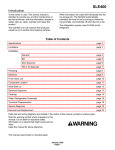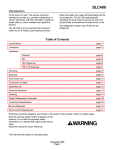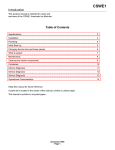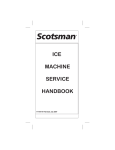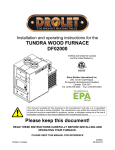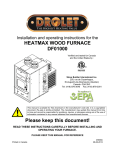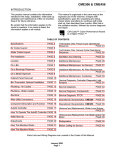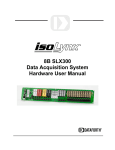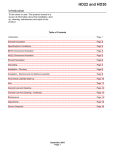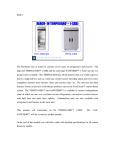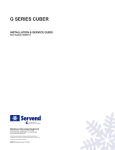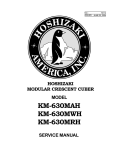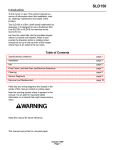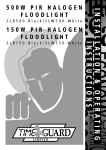Download Scotsman SLE400R Service manual
Transcript
SLE400R Introduction To the owner or user: This service manual is intended to provide you, and the maintenance or service technician, with the information needed to install, start up, clean, maintain and repair this product. The SLE400R is an ice machine that produces cubed ice on 6 vertical cube freezing surfaces. When harvested, the cubes fall individually into the ice storage bin. The SLE400R automatically maintains the level of ice by turning on when the ice level falls, and switches off when the bin is full. The refrigeration system uses R-404A as the refrigerant. Table of Contents Specifications . . . . . . . . . . . . . . . . . . . . . . . . . . . . . . . . . . . . . . . . . . . 2 For The Installer: Environmental Limitations . . . . . . . . . . . . . . . . . . . . . . . . . . . 3 Installation 4 . . . . . . . . . . . . . . . . . . . . . . . . . . . . . . . . . . . . . . . . . . . . Installation: Ice Storage Bin . . . . . . . . . . . . . . . . . . . . . . . . . . . . . . . . . . . Installation: SLD150 Hotel Dispenser 5 . . . . . . . . . . . . . . . . . . . . . . . . . . . . . . 6 Installation: Scotsman IS or RS Dispenser . . . . . . . . . . . . . . . . . . . . . . . . . . . . 7 installation . . . . . . . . . . . . . . . . . . . . . . . . . . . . . . . . . . . . . . . . . . . . 8 Installation: Remote Condenser System . . . . . . . . . . . . . . . . . . . . . . . . . . . . . 9 Installation 10 . . . . . . . . . . . . . . . . . . . . . . . . . . . . . . . . . . . . . . . . . . . . After Utility Connections . . . . . . . . . . . . . . . . . . . . . . . . . . . . . . . . . . . . . 11 Component Location . . . . . . . . . . . . . . . . . . . . . . . . . . . . . . . . . . . . . . . 12 Initial Start Up . . . . . . . . . . . . . . . . . . . . . . . . . . . . . . . . . . . . . . . . . . . 13 Initial Start Up . . . . . . . . . . . . . . . . . . . . . . . . . . . . . . . . . . . . . . . . . . . 14 Maintenance, Cleaning and Sanitizing . . . . . . . . . . . . . . . . . . . . . . . . . . . . . . 15 Cleaning: Ice Machine Water System . . . . . . . . . . . . . . . . . . . . . . . . . . . . . . 16 How It Works: . . . . . . . . . . . . . . . . . . . . . . . . . . . . . . . . . . . . . . . . . . . 17 Technical Characteristics . . . . . . . . . . . . . . . . . . . . . . . . . . . . . . . . . . . . . 18 Service Diagnosis: . . . . . . . . . . . . . . . . . . . . . . . . . . . . . . . . . . . . . . . . 19 Removal and Replacement . . . . . . . . . . . . . . . . . . . . . . . . . . . . . . . . . . . . 22 Removal and Replacement . . . . . . . . . . . . . . . . . . . . . . . . . . . . . . . . . . . . 23 Removal and Replacement: Refrigeration System . . . . . . . . . . . . . . . . . . . . . . . . 24 Parts lists and wiring diagrams are located in the center of this manual, printed on yellow paper. Keep this manual for future reference. This manual was printed on recycled paper. Note the warning symbol where it appears in this manual. It is an alert for important safety information on a hazard that might cause serious injury. January 1995 Page 1 SLE400R Specifications Information regarding Model Number, Serial Number, Ampacity and Maximum Fuse Size are located on the nameplate of the ice machine. The model number, serial number and refrigerant charge are also listed on the serial number plate just behind the front panel. Nameplate Serial Number Plate If recharging, always use the charge listed on the ice machine. SLE400R Cabinet Discharge Line Fitting (3⁄8" OD) Liquid Line Fitting (1⁄4" OD) Water Inlet Electrical Inlet Specifications: The SLE400R will stack onto a variety of ice storage bins, see sales literature for proper ice storage bin. SLE400R Back View Drain Model Number SLE400RS-32A Dimensions W" x D" x H" 22 x 23 x 20 Condenser Type Remote Air Basic Electrical Minimum Circuit Ampacity* 208-230/60/1 * Minimum Circuit Ampacity is used to determine wire size and type per the National Electric Code. Note: Do not connect this refrigeration system to a used condenser circuit. Only the condenser and line set specified for this machine may be used. 16.5 Maximum Fuse Size (or HACR circuit breakers) 20 Condenser: • RCE400-32A Line Set: • RTESL25 or RTESL40 January 1995 Page 2 Refrigerant Charge. R-404A 136 ounces SLE400R For The Installer: Environmental Limitations The ice machine must be installed indoors in a controlled environment. Minimum Maximum 0 Air Temp 55 F. 1000F. Water Temp 400F. 900F. Water Pressure 20 PSI 60 PSI Voltage 253 198 Operating the ice machine outside of the above limitations, or outdoors, is potentially damaging to the machine, and it is misuse of the machine. This may void the warranty. Scotsman Ice Systems are designed and manufactured with the highest regard for safety and performance. They meet or exceed the standards of UL, NSF, and CSA. Scotsman assumes no liability or responsibility of any kind for products manufactured by Scotsman that have been altered in any way, including the use of any part and/or other components not specifically approved by Scotsman. Scotsman reserves the right to make design changes and/or improvements at any time. Specifications and design are subject to change without notice. SLE400R Top View Dashed Lines Show Outline of Ice Drop Area. Bin Control Mounts to Right of Ice Drop Area. 12" 23" 7" 3" 6 1⁄2" January 1995 Page 3 SLE400R Installation Water Location The water supply for this ice machine has been in contact with many materials since it fell from the sky as rain. All rain is slightly acidic, and tends to dissolve the materials it comes in contact with. During water’s journey to the ice machine, it has flowed over and through the ground, been picked up by a municipal or private pump, forced through a series of pipes of differing construction and may have been treated by the municipality providing the water. This ice machine may be installed in the open or under a counter. Clearance may be required at the sides, and is required at the back. Air cooled models take air in from the right and blow it out the back. Space is required for utility connections at the back. The water supplied to this ice machine will then contain a variety of substances that will likely show up as solids during the ice making process. These solids are similar to those found when water is boiled out of a saucepan. Only the water boils away, and the minerals that were in the water solidify in the pan. During ice making only the water is frozen into ice, the minerals stay behind in the reservoir. This machine drains out some water in the reservoir every cycle to minimize the amount of minerals in the water system, but after time the minerals will appear and have to be dissolved by ice machine cleaner, then flushed away during the cleaning process. The remote condenser may be located outdoors, use the following formula for planning the placement of the condenser relative to the ice machine: An ice machine is a food manufacturing plant; it takes a raw material, in this case water, and transforms it into a food product, ice. The purity of the water is very important in obtaining pure ice and in maximizing product life. The water to the ice machine should be filtered. Water filters vary greatly in ability and function. Install one that filters out suspended solids to a dimension of 5 microns or less. The finer the filter the better, but finer filters may plug-up sooner than course ones. It may be necessary to add a course filter ahead of the fine filter to prolong filter life. Polyphosphate feeders are usually effective in many water conditions. Have the water tested. Acidic water or alkaline water will both cause corrosion. Dissolved solids cannot be filtered out. Softened water is not recommended. Never use de-ionized water. Reverse-osmosis water must be treated with buffering agents before use in the ice machine. Check with a water treatment specialist regarding testing, treatment and filters. The ice machine is NOT designed for outdoor use. It must be installed indoors, in a controlled environment. The air and water temperatures must not exceed rated limits. • Maximum rise from ice machine to condenser is 35’ • Maximum drop from ice machine to condenser is 15’ Formula: • Drop = n x 6.6 • Rise = n x 1.7 (n = distance in feet) • Maximum distance is 100 equivalent feet. For example: • The condenser is to be located 5’ below the ice machine and 20’ away. • 5’ x 6.6 = 33 equivalent feet. 33 + 20 = 53 equivalent feet. This location would be acceptable. Pre-installation: 1. Inspect the place where the ice machine is to be installed. Check for: • space for the cabinet, • water supply, • drain availability • and electrical power supply. No extension cords are allowed. The building drain inlet must be lower than the drain outlet of the ice bin. The water supply must have a hand shut off valve accessible when the unit is installed. Remote Condenser: A new condenser coil designed for the machine’s capacity must be used. Because of the possibility of mineral oil contamination, coils and line sets that had been connected to R-12, R-404A or R-22 units may not be connected to this system. Doing so voids the refrigeration system warranty. January 1995 Page 4 SLE400R Installation: Ice Storage Bin Assembly: Stacking: 1. Attach the legs, or optional casters, onto the ice storage bin. Units that are stacked should only use legs, not casters. This machine will stack onto any SLC300, 400 or SLE400R. Note: Do not use casters when stacking. Note: One condenser per remote unit. 2. Be sure that the top edge of the bin has a good gasket on it. 1. Remove and discard the left top panel from the lower unit. 3. Place the ice machine onto the storage bin. 2. Remove knock out plug from top right panel. 4. Line up the ice machine, check that there is a good seal between the ice machine and the storage bin. 3. Place gasket material around the top of the bottom unit’s cabinet & evaporator compartment. 5. If on a Scotsman bin, attach the ice machine to the bin using the straps and bolts shipped with the ice machine. Drill two 1/8" holes in the back of the bin and secure with sheet metal screws provided. If on another brand bin, follow the directions included with that bin. Bin Thermostat Installation: 4. Carefully lift the uncrated top unit onto the bottom unit. Use of a mechanical lift is recommended for this step. 5. Align the two ice maker cabinets. 6. Secure the top unit to the bottom one with the hardware and straps shipped with the upper machine. 1. Remove thermostat bracket from package. 7. Locate and uncoil all of the bin thermostat capillary tube. 2. Attach the bin thermostat bracket to the bottom of the ice machine using the thumb screws provided. There are pre-drilled and tapped holes located just to the right of the cube drop area. 8. Route the bin thermostat capillary tube from the upper unit, through the hole in the base, through the lower unit and into the bin thermostat bracket. Discard upper unit bracket. Bin Thermostat Installation Stacking Routing Hole Bin Thermostat Bracket Capillary Tube Fasten Cabinets Together At Back With Straps & Screws. Bin Thermostat Bracket Thermostat Capillary Tube 3. Locate and uncoil a portion of the bin thermostat capillary tube. Route the end of the capillary tube into the plastic tube in the base of the ice machine (next to the compressor) and through the bin thermostat bracket. Note: SLB150: Use thermostat bracket packed with that bin. January 1995 Page 5 SLE400R Installation: SLD150 Hotel Dispenser Assembly The ice machine must be placed onto the top of the dispenser, and the bin thermostat capillary tube routed into the bracket in the dispenser. 1. Check that the dispenser has a gasket all around the perimeter of the top, 22" wide by 23" deep. 2. Locate the inlet hole of the thermostat bracket, and make sure that it is open. 3. Place a corner post from the ice machine carton at the front of left and right sides of the hotel dispenser top. 4. Use a mechanical lift and place the ice machine onto the dispenser. The cardboard corner posts should keep the front edge of the ice machine up. 5. Remove the front panel of the ice machine. 6. Locate the bin thermostat capillary tube and uncoil about 18" of tubing. 7. Locate plastic tube in base of ice machine, next to compressor and push the end of the capillary tube thru the tube, watch the capillary as it comes out of the base, line it up with the inlet hole of the thermostat bracket and push it into the hole. Move the cabinet of the ice machine until the capillary tube is going straight down into the inlet hole. Bin Thermostat Capillary Tube Installation Route Capillary Tube Through Plastic Tube In Base 8. Carefully remove the corner posts. 9. Push the capillary tube into the thermostat bracket tube until about 14" of capillary tube is in the tube. 9 Remove the hardware package from the machine, remove brackets. 10. At the back of the dispenser, fasten brackets to the ice machine. 11. Using brackets for templates, drill 1/8" holes into the back of the dispenser. Bin Thermostat Bracket Mounted In Dispenser 12. Secure brackets to the dispenser with sheet metal screws from the hardware package. 13. Follow other installation instructions from the SLD150. January 1995 Page 6 Temporarily Support Machine With Corner Posts To Observe Cap Tube Installation SLE400R Installation: Scotsman IS or RS Dispenser Assembly: The assembly of the ice machine onto the dispenser requires two additional parts: an adapter kit and a thermostat stand off kit. 1. Mark two spots on the inside left liner of the dispenser: 2" down from the top, 4" from the back, and 4" apart. 7. From the adapter kit, place the stainless steel adapter onto the top of the dispenser. Follow all directions included with the kit. 8. After the ice machine has been placed on the dispenser, remove the front panel and uncoil all of the bin thermostat capillary tube. 2. At the two marked spots, drill two 1/4" holes thru the plastic liner only. 9. Route the capillary tube thru the front hole in the base of the ice machine, to the left side if the dispenser towards the stand offs. 3. From the stand off kit, locate the stand offs and plastic anchors. Thread the stand offs partially into the plastic anchors. 10. Route the end of the capillary tube thru the stand offs, bend the tube around the stand offs so that it does not fall off. 4. Push the anchors/stand offs into the holes. 11. Check that the routing of the capillary tube is away from the ice chute and up high near the base of the ice machine. 5. Screw the stand offs all the way into the anchors. Be sure that the holes in the stand offs are horizontal. 6. Place a bead of silastic (from the kit) around the stand offs. Installation of Bin Thermostat Capillary Tube Route Capillary Tube Through Front Plastic Tube K1 Kit Adapter RS or IS Dispenser Stand Offs From Kit K6 Drill 2 Holes For Stand-Offs: 2" From Top Of Dispenser & 4" From Back & 4" Apart Route Capillary Tube Through Stand Offs January 1995 Page 7 SLE400R installation For The Plumber Supply: Screw the 3/8" male flare (fitting shipped in package inside cabinet) into the 1/4" FPT fitting at the back of the cabinet (thread tape recommended). Connect cold potable water to the water inlet. A hand shut off valve for inlet water should be installed near the machine. A water filter is recommended. Flush the water line prior to connecting to the ice machine. Drains: Connect a drain tube to the reservoir drain fitting at the back of the cabinet. The drain tube from the fitting must be run separately from any other drain tube. The reservoir drain is a 3/4" F.P.T. brass fitting. The bin drain must be vented if there is a long horizontal run (5’ or more). The reservoir drain must be vented and not connected to the bin drain. All drains are gravity, and must have a minimum fall of 1/4" per foot of horizontal run. Maintain the air gap required by local code between the end of the drain tubes and the building drain receptacle. Note: Drain tubing should be insulated to prevent condensation from forming on the tubing. CONFORM TO ALL LOCAL CODES Drain tube material must be rigid and meet local code. Traps in the bin drain line without vents ahead of them will cause poor draining. 3/8 Male Flare Water Inlet Water Shut Off Valve Reservoir Drain 3/4" FPT, Must Be Vented. Ice Storage Bin (Typical) Bin Drain. May Be Routed From The Bottom On Some Model Bins. Fitting May Be Plastic. DO NOT OVERHEAT. Water Supply and Drain Connections January 1995 Page 8 SLE400R Installation: Remote Condenser System Remote Condenser The remote condenser may be located within 100 equivalent feet of the ice machine (per the formula). Follow all local building codes for the condenser’s location. If placed on a roof, a roofing specialist should install it. Pre-Charged Line Set Remote Condenser Precharged Lines There are two precharged lines required for each ice machine to condenser connection: a 1/4" liquid line and a 3/8" discharge line (the discharge line is insulated). Each contains a minor holding charge that matches the type of refrigerant in the ice machine and in the condenser. The ice machine contains the entire system charge in the receiver. From the formula, plan the routing of the tubing. Do not leave any excess tubing on the roof: the condenser must be located as close as possible to the place where the tubing goes through the roof. Route the tubing to the condenser and to the ice machine. Be certain that there is no metal to metal or tight tube to tube contact between the liquid and discharge lines. Coil excess tubing inside the building in a horizontal spiral. If there is considerable excess tubing, it should be cut out before the tubing is connected to the ice machine. Be certain to evacuate the tubing before connecting to the ice machine or to the remote condenser. Connections: Remove plastic caps from condenser, tubing connections and from the ice machine’s refrigerant tubing connections. Lubricate all threads and o-rings with refrigeration oil. Tighten all fittings until a significant resistance is felt. Then using two wrenches, (one holding the tubing so that it does not rotate) tighten the connections 1/4 turn more. Check fittings for leaks and have the roof hole sealed. Wiring: The remote condenser fan motor takes its power from the ice machine. Wire per electrical codes and the wiring diagram. January 1995 Page 9 Installation of Remote Condenser SLE400R Installation For The Electrician This unit must be on a separate 230 volt AC 60 cycle single phase power supply. The maximum fuse size for this circuit is listed on the nameplate, and per the nameplate use fuses, or HACR circuit breakers. The remote condenser fan motor is powered from the ice machine, thru the junction box at the back of the ice machine. Follow All Local Codes - This Unit Must Be Grounded. Usually a licensed electrician will be required to connect the electrical service. The remote condenser fan motor requires an electrical connection in the ice machine junction box. See wiring diagram. Remote wiring must be in liquid tight or rain proof conduit as required by local codes. To make the electrical connections: The fan motor voltage is 208-230. 1. Remove the right top panel. An appropriate outdoor junction box may be required to be added to the remote condenser. 2. Remove the junction box cover. 3. Make the electrical connections to the wires in the junction box. A ground screw is provided in the junction box. Remote Electrical Connection Power Supply for Ice Maker and Condenser Junction Box SLE400R BACK VIEW January 1995 Page 10 SLE400R After Utility Connections 1. Level the cabinet, use the leg levelers on the end of the legs to adjust the cabinet height. (Legs should have been installed when the bin was unpacked). 2. Wash out the bin. If desired, the interior of the bin could be sanitized. Final Check List 1. Is the ice maker cabinet in a room where ambient temperatures are within the minimum and maximum temperatures specified? 2. Has the water supply been connected? 3. Is the water pressure adequate? 4. Have the water connections been checked for water leaks? 5. Have the drain connections been made? 6. Have the drain connections been checked for leaks? 7. Is the cabinet level? 8. Is the ice machine connected to a 230 volt electrical power supply and is the ice machine the only load on that circuit? 9. Has all of the shipping material been removed from the inside of the cabinet? 10. Has the bin thermostat been installed? 11. Has the remote condenser been installed in an acceptable location? 12. Have the precharged tubes been connected? 13. Has the ice maker to remote condenser electrical connection been made? 14. Has the bin and cabinet been wiped clean and sanitized? 15. Has the Customer Evaluation & Warranty Registration form been properly filled out? Check for correct model and serial numbers from the nameplate, then mail the completed form to Scotsman. 16. Has the owner/user been given the name and telephone number of the authorized Scotsman Service Agency serving that location? January 1995 Page 11 SLE400R Component Location Many components are serviceable from the front without removing the side panels. Control Box Detail Ice Size Thermostat Behind the front panel: • Water pump • Inlet water valve • Reservoir • Evaporators • Water distributor pan • Ice size control adjustment • ICE/OFF/WASH switch • Control box Contactor High Pressure Cut Out Compressor Relay Harvest Relay Bin Thermostat Ice/Off/Wash Switch Ice Thickness Control Control Box Water Distributor Pan Bin Thermostat ICE/OFF/WASH Switch Bin Thermostat Bracket Water Pump Water Inlet Valve & Strainer Drain Elbow Component Location January 1995 Page 12 SLE400R Initial Start Up After the final check list has been gone through, the ice machine may be started up. Ice Size Adjustment 1. Open the water shut off valve; the inlet water valve will open, and water will flow into the reservoir.. Ice Thickness Probe Adjustment Plate: Move UP for Larger 3. Remove the front panel. Cubes, 3. Locate the ICE/OFF/WASH switch, DOWN for Smaller Cubes switch it to WASH. 2. Switch on the electrical power. Set Screws 4. The water pump will begin to pump water over the evaporators. 5. Allow the reservoir to refill. Normal water level is 1/8" below the high point of the lower curve of the siphon u-tube. Cube Size Diagram 6. Switch the ICE/OFF/WASH switch to OFF. 7. Check the action of the siphon. The water level in the reservoir should drop to the bottom curve of the U-bend (normal water level) in about 2 minutes. If not, check for proper drain tube connections. Cubes Too Thick 8. Remove right side panel. 9. Remove cap from “king” or service valve on the receiver, and open the valve. 10. Switch the ICE/OFF/WASH switch to ON. 11. The remote fan motor will begin to turn, and warm air will be discharged from the top of the remote condenser. 12. The water temperature in the reservoir will soon be 320F., and ice should begin to form on the evaporators. 13. Allow the ice machine to operate for about 20 minutes. The ice should be fully formed and should be harvested within a few minutes. Correct Size & Shape 14. After harvest, check the ice cube size. Compare a fresh cube to the diagram on the back of the front panel. If needed, adjust the cube size by loosening the set screws and moving the ice thickness probe adjustment plate. Move the adjustment plate down for smaller cubes and up down for larger. For proper operation, the ice thickness should be set to the 1 11⁄16" diameter. The machine is designed to harvest cubes of only the correct thickness. January 1995 Page 13 Cubes Too Thin 1 11⁄16" SLE400R Initial Start Up Note: If the first batch of cubes are not all uniform discs, some ice machine cleaner should be added to the reservoir. 1. After ice has been harvested, but before new cubes begin to form, switch the ICE/OFF/WASH switch to WASH. 2. Add 4 oz. of ice machine cleaner to the reservoir. Allow unit to operate that way for 10 minutes. 3. Switch ICE/OFF/WASH switch to OFF 4. Shut the water supply off. 5. Remove the splash guard, and drain the reservoir by removing the drain elbow. 7. Replace all parts, turn on the water and move ICE/OFF/WASH switch to ICE. The next batch of ice should be uniform. 13. Check harvest. The machine will have to harvest all of the cubes before it goes back into the freeze cycle. 14. Check operation of the bin control circuit by holding ice on the bin control tube in the bin. If the ice maker does not stop within 1 minute, while keeping ice on the thermostat, rotate the bin thermostat shaft counter clockwise until the ice maker does stop. Remove the ice from the capillary tube; the ice maker should restart within 2 minutes. If it does not, rotate the adjusting shaft clockwise until the machine starts. 15. Replace all the panels. The ice machine is now ready for automatic operation. Siphon Tube Schematic U-Tube Adjusted Here = No Purge Electrical Sequence: Freeze Cycle: During the first part of the freeze cycle, the ice machine compressor, fan motor and water pump are operating. Assume the bin thermostat is open (low ice), relay K1 will NOT have power thru its coil and K1 contacts 6-2 will be closed, connecting power to the ice size thermostat and the liquid line valve coil. The ice size thermostat contact 2-3 are closed, connecting power to the fan motor and the pump motor. The Harvest Termination Thermostat is closed to NC, but there is no power thru it. The ice size thermostat heater is on, and the compressor contactor coil is energized. Harvest: In the harvest cycle, the compressor is operating, and the hot gas valve is energized. The fan and and pump are off. The bin thermostat is still open. The when the ice near the ice size thermostat sensing tube grows large enough to force water over the sensing tube, that tube looses heat, and at 38oF. contacts 2-3 open and 2-1 close. This removes power from the water pump and remote fan and connects power to the relay coil. When the relay coil has power, it connects power to the hot gas valve coil. The harvest termination switch is closed, and power flows thru it to the relay coil. This keeps the relay energized, even when the ice size thermostat switches contact position as a result of ice falling away from the sensing tube. The unit stays in the harvest cycle until the thermodisc on the suction line warms up to 55oF., U-Tube Here = At that time the defrost themodisc switches to NO Maximum Purge and the harvest cycle is terminated. If the bin Water Level thermostat is still open, relay K1 will still not have At Harvest power and the unit will go back into the freeze Water Level With cycle. If relay K1 has power, it shuts off the ice Pump ON machine by cutting power to the liquid line valve, after the unit pumps down, the low pressure Water Inlet control shuts off the compressor. Siphon Breaker Hole 1/8 - 1/4 Drain Outlet Elbow Bottom of Reservoir Whenever there is ice on the bin thermostat, it closes a circuit to the coil of relay K1 and stops the ice making process at the end of a harvest cycle. The crankcase heater is on at all times. January 1995 Page 14 SLE400R Maintenance, Cleaning and Sanitizing Cleaning Schedule: Ice Storage Bin • Scrub the outside of the cabinet once a week with soap and water. • Sanitize the bin interior once a month. • Clean the water system and air cooled condenser a minimum of twice per year. If in an area of high mineral concentration in the water supply, clean water system 4 times a year. Inlet Water Valve Screens If a restriction of incoming water is suspected, there may be a strainer in the water line; the strainer screen should be inspected for restricting minerals. Water filters should be changed. Air Cooled Condenser: The interior liner of the bin is in contact with a food product: ice. The storage bin must be cleaned regularly to maintain a sanitary environment. Once a week cleaning with soap and water, a hot water rinse and an air dry is a basic procedure. Every 30 days, the liner should be sanitized with a commercial ice machine sanitizer, according to the directions of the sanitizer, or with a solution of household bleach and water: 1. Mix the bleach and water using the ratio of two ounces of bleach to two gallons of water. 2. Wipe all interior surfaces of the ice storage bin with the bleach and water. 3. Allow to air dry. Shut the unit off. To Remove Scale: The fins of the condenser will become fouled with dirt, and must be cleaned. A vacuum cleaner with a soft brush attachment will extract most loose dust stuck to the surface of the condenser fins.. 1. Mix a cleaning solution of 4 ounces of Scotsman Ice Machine Cleaner to 4 pints of warm (950F.-1100F.) water. 2. Using rubber gloves, dip a nylon scouring pad into the cleaning solution and scrub the scale off the liner. 3. After the scale has been removed, rinse all surfaces inside the bin with clean, potable water. Stainless Steel Bin Liner The stainless steel liner of the bin will require periodic cleaning. Chemicals in the water supply, such as chlorine, cause brown stains to appear on the surface of the stainless steel parts. 1. General Cleaning - staining is usually removed by washing the parts with ordinary cleaning powder such as Bon-Ami or Copper-Glo and water. After cleaning, rinse with clear water. 2. Water treatment. The chlorine enters the machine from the municipal water supply. It can be removed from the water supply by using a charcoal or activated carbon water filter to treat the water to the ice machine. If staining is severe, filters of this type are recommended. Exterior Cabinet Cleaning: The exterior cabinet may be cleaned by scrubbing with soap and water. Do not use cleaners containing petroleum products. A nylon type brush may be used to scrub stubborn deposits. January 1995 Page 15 SLE400R Cleaning: Ice Machine Water System Dissolve and Remove Minerals: 15. Shut the water supply off by pushing the water valve button in. 1. Remove front panel. 16. Drain the water from the sump by removing the drain elbow. 2. Move the ICE/OFF/WASH switch to OFF. 3. Remove the splash guard. 4. Shut the water supply off by pushing the water valve button in. 5. Drain the water from the sump by removing the drain elbow. 6. Disconnect hose from the water distributor pan, and remove the water distributor pan. 7. Mix a solution of 5 oz. ice machine cleaner and 1 gallon of warm (95oF. - 115oF.) water. Scotsman Ice Machine Cleaner contains acids. These compounds may cause burns. If swallowed, DO NOT induce vomiting. Give large amounts of water or milk. Call Physician immediately. In case of external contact, flush with water. KEEP OUT OF THE Sanitize: 17. Remove the water distributor pan. 18. Mix a sanitizer solution of 1 ounce of household bleach to 2 gallons of warm (95oF. 115oF.) water 19. Wash the splash guard and the water distributor pan with the solution of sanitizer. Allow to air dry. 20. With the sanitizer solution, wash the refrigeration tubing, liner, evaporators, support brackets and water pump assembly; use the brush and/or a clean cloth. 21. Replace the water distributor pan and splash guard. Be certain that the hose to the water distributor pan is tightly connected to the pan, and that the flow washer in the hose is not in sideways. 22. Replace the drain elbow. 23. Add ice machine sanitizer solution to the sump area until it is full. 8. Wash the splash guard, drain elbow and water distributor pan with the ice machine cleaner/water solution. 9. With the solution of ice machine cleaner and water, wash the refrigeration tubing, liner, evaporators, support brackets and the water pump assembly. Use the brush and/or a clean cloth. 10. Replace the drain elbow. 11. Open the water supply by pushing the water valve button in (to its original position) and allow the sump to refill. 12. Add 5 oz. ice machine cleaner to the sump area. 24. Move the ICE/OFF/WASH switch to WASH add more sanitizer solution to the sump area until it is full again. 25. After 5 minutes, move the ICE/OFF/WASH switch to OFF. 26. Remove the splash guard. 27. Drain the water from the sump by removing the drain elbow. 28. Replace the drain elbow and splash guard 29. Open the water supply by pushing the water valve button in (to the original position) and allow the sump to refill. 30. Move the ICE/OFF/WASH switch to ICE. 31. Replace the front panel. 13. Replace the water distributor pan and splash guard. Be certain the hose to water distributor pan is connected to pan. 32. Discard first batch of ice and all other batches until all traces of cleaner and sanitizer disappear. 14. Move the ICE/OFF/WASH switch to wash and allow the solution to circulate for 15 minutes, then move the ICE/OFF/WASH switch to OFF. 17. Remove the splash guard. January 1995 Page 16 SLE400R How It Works: Refrigeration: Freeze Cycle: Water: From the compressor, hot discharge gas is pumped to the remote air cooled condenser. Water flows into the ice machine from its inlet connection at the back of the cabinet, through the inlet water valve and into the reservoir. The water in the reservoir is pumped up and through the water distributor tube at the top of the evaporators. From there, the water flows over both sides of the evaporators and back into the reservoir. At the condenser, if the discharge pressure is over 225 PSIG, the discharge gas will flow thru the condenser coil. Heat from the refrigerant flows into the air, and the refrigerant condenses into a liquid. If the discharge pressure is below 225 PSIG, the refrigerant will not flow thru the coil, but will be forced into the liquid line. From the condenser the liquid refrigerant flows through the liquid line to the liquid line check valve. When the machine is on, the check valve is open to flow from the condenser to the receiver. From the receiver, refrigerant then flows to the metering device - a thermostatic expansion valve. At the expansion valve, the liquid refrigerant passes from a high pressure zone to one of relatively low pressure, and in the low pressure zone it evaporates. The low pressure zone where the refrigerant evaporates is the evaporator. When the refrigerant evaporates, it absorbs heat from the metal parts of the evaporator and the water flowing over it. From the evaporator, the refrigerant flows back to the compressor through the suction line. Note: During the time that the machine is off, the the pump down system (liquid line valve) keeps the refrigerant out of the low side of the system, and the liquid line check valve keeps liquid refrigerant from flowing back into the liquid line and remote condenser. Melted ice and water spills into the bin flow through a drain in the base of the bin to the exterior drain connection at the back of the cabinet. Refrigeration: Harvest Cycle: The ice maker continues to freeze the water into ice until the ice next to the ice size thermostat probe has become thick enough to force water over the probe. After the cold water has reduced the temperature of the probe to 380F., the ice size thermostat will switch the machine into the harvest cycle. During the harvest cycle, the refrigerant flows from the condenser, through the discharge line to a branch in the line containing the Hot Gas Valve. This valve is Open during the harvest cycle, allowing the hot discharge gas to bypass the condenser and enter the evaporator at its inlet. The hot discharge gases warm up the evaporator enough to allow the surface of the ice frozen to the evaporator to melt. The remaining ice will then fall off into the bin. During the Harvest Cycle, the water level rises, filling the reservoir over the siphon tube and siphoning some of the reservoir water out to the drain. The harvest cycle continues until the suction line warms up enough to cause the harvest termination thermostat to switch the machine back into the freeze cycle. January 1995 Page 17 SLE400R Technical Characteristics Typical Cycle Time • 17 minutes @ 70oF. air and 50oF. water • 24 minutes @ 90oF. air and 70oF. water Typical Harvest Ice Weight • 4 pounds . Typical Low Side Pressure • 22 - 23 PSIG just before harvest (beginning of freeze may be 45 - 50 PSIG) Typical Freeze Cycle Discharge Pressure • 240 - 260 PSIG • Minimum (low temps) = 225 PSIG Refrigerant Charge: • 136 ounces R-404A Harvest Time • Normally 11⁄2 to 2 minutes. Depends upon time required to warm suction line to 55oF. Typical Suction Pressure, In Harvest: • 110- 120+ PSIG Typical Discharge Pressure, In Harvest: • 130 - 150 PSIG Typical Compressor Amp Draw: • 4 - 5 during freeze cycle; 5 - 6 during the harvest cycle Compressor: • Copeland: RS64C1E-CAV-214 Thermostatic Expansion Valve • Superheat is 3o - 6oF. Pump down pressure control • Cut Out at about 10 PSIG • Cut In at about 25 PSIG Bin Thermostat • Cut In to shut off machine at 35oF., cut out at 39oF.. Adjustable warmer. Ice Size Thermostat: • Switches to harvest cycle with temperature fall to 38oF.. Resets at 43oF. Ice Size Heater • Adds heat to ice size thermostat to prevent premature harvest. Harvest Termination Thermostat • Switches from contacts C-NC to contacts C-NO to switch to freeze cycle with temperature rise to 55oF. Resets at 40oF. January 1995 Page 18 SLE400R Service Diagnosis: SYMPTOM No ice is made, nothing operates No ice, compressor off No ice is made, compressor is operating POSSIBLE CAUSE Unit off, due to no power Unit off, due to ICE/OFF/WASH switch in OFF position Unit off, due to bin thermostat closed Unit off, due to high pressure cut out open No cooling due to compressor not operating Unit off, due to low pressure (pump down) control open. No water due to water turned off. No water due to water filter plugged. No water due to strainer screen plugged No water due to inlet water valve will not open Water in reservoir, but no water over evaporators No cooling at evaporator due to hot gas valve leaking thru No cooling at evaporator due to fan not turning Fan and pump do not have power; hot gas valve opens and closes. No cooling at evaporator due to dirty condenser No cooling due to compressor not pumping January 1995 Page 19 PROBABLE FIX Restore power Switch ICE/OFF/WASH switch to ICE Check temperature at bin thermostat bracket, if warmer than 40o F., thermostat should be open. Adjust/replace thermostat. Check fan motor. Check compressor for voltage, continuity, and operation. Check starting components. Replace if found to be faulty. If no voltage, check contactor, replace if coil or contacts open. Check temperature of compressor, if hot may be lack of refrigerant, defective TXV or compressor Check liquid line valve coil for power and/or continuity Reconnect water supply Replace water filter Clean out inlet screen Replace valve Water pump does not work, replace pump Replace hot gas valve Check & replace fan motor. Coil or relay open, replace relay. Clean condenser Check system pressures, replace compressor if not pumping SLE400R Service Diagnosis: SYMPTOM No ice compressor is operating POSSIBLE CAUSE No cooling due to low refrigerant charge Ice is made, but not harvested. Ice size thermostat contacts do not switch position Ice will not slide down ice rack due to minerals on rack. Ice will not slide down ice rack due to ice rack out of position Ice will not slide down ice rack due to bent ice rack Lack of heat during harvest cycle due to unit in air temp. less than 550F. Lack of heat during harvest due to water flowing thru water cooled condenser Lack of heat during harvest due to lack of refrigerant Lack of heat during harvest due to hot gas valve not opening fully. Ice does not slide down face of evaporator due to minerals on evaporator surface Harvest cycle too short due to harvest termination thermostat opens at too low a temperature. January 1995 Page 20 PROBABLE FIX Locate leak, recover remaining refrigerant, replace dryer, evacuate and weigh in nameplate charge. Ice not made near thermostat probe due to water distributor holes restricted. Clean water distributor pan. Thermostat defective, replace it Clean machine with ice machine cleaner. Reposition ice rack Replace ice rack Warm up air or move machine. Replace water regulating valve Check low side pressure during harvest. If low either the charge is low or the hot gas valve does not open fully. If charge is the problem, locate leak, recover remaining refrigerant, repair leak, replace drier, evacuate and weigh in nameplate charge. Check low side pressure during harvest. If low either the charge is low or the hot gas valve does not open fully. Clean water system with ice machine cleaner Replace harvest termination thermostat SLE400R Service Diagnosis: SYMPTOM Ice is made, but will not harvest POSSIBLE CAUSE Will not harvest due to hot gas valve not opening. Slow/incomplete harvest due to hot gas valve not fully open. Makes ice, but very little Cubes are wrong size/shape High discharge pressure, due to dirty condenser; faulty fan motor; Inlet water temperatures and room ambient very high Long freeze cycle due to hot gas valve leaking thru. Compressor inefficient Ice size thermostat not adjusted properly Freeze cycle too short due to heater open Water system is restricted with minerals Ice thickness probe tube covered with minerals Not enough water Too much superheat Ice fused together in bin Ice in bin too long Unit does not shut off Too many minerals in water Bin control will not close K1 relay coil open January 1995 Page 21 PROBABLE FIX Check for voltage to coil in harvest, if there is voltage replace hot gas valve Check low side pressure in harvest, replace hot gas valve if too low with correct ref. charge. Check for causes of high discharge pressure and correct. Advise user, suggest additional room cooling. Check temperature of tubes to and from hot gas valve; there should be a temperature drop across the valve in the freeze cycle. Replace valve if temps are nearly equal. Check/replace compressor Adjust ice size thermostat; use gauge shipped with machine Check/replace heater on ice size thermostat probe tube. Clean water system with Scotsman Ice Machine Cleaner Clean tube with ice machine cleaner Check water supply pressure Check water supply for restrictions Check superheat, replace TXV if too high. Check hot gas valve for leak-thru; replace if leaks thru. Advise user to pour water on ice to ease removal Suggest water treatment to user. Check & replace bin control Check & replace K1 relay SLE400R Removal and Replacement Ice Size Thermostat: Primary Resistor (Heater) Before replacing the ice size thermostat, it should be positively determined that it is at fault. 1. Disconnect electrical power. 1. Disconnect electrical power. 2. Disconnect the primary resistor’s yellow wire from terminal #4 and the white wire from terminal #1. Pull the two wires out of the control box and thru the insulated wall. 3. Mark location of probe tube bracket. Electrical shock hazard. Electrical shock can cause personal injury. Disconnect power before beginning to service components. 4. Remove two screws and the probe tube bracket from the evaporator. 5. Remove the plastic sleeve and heater from the tube. 6. Replace heater and plastic tubes. 7. Place probe tube bracket on evaporator in its original position. Probe tube must be inserted into plastic guide attached to evaporator. 2. Remove the front panel. Evaporator 3. Remove the control box cover. 4. Locate the ice size thermostat. 5. Remove the two screws holding the control to the control box, and lift the control out. Heater 6. Pull the three wires off the posts of the ice size thermostat. 7. Follow ice size thermostat capillary tube to ice size probe. Capillary Tube 8. The end of the ice size thermostat is inserted in a tube. Pull it out of the tube. Probe Tube Bracket 9. Follow the capillary tube of the ice size thermostat and pull it thru the insulated wall and the grommet in the side of the control box. 10. Remove thermostat from control box. Replacement of Ice Size Thermostat 11. Replace the ice size thermostat with the proper part number, following the above steps from 9-1. 8. Replace wires. 9. Reconnect power, restart ice maker. Check ice size. January 1995 Page 22 SLE400R Removal and Replacement Water Pump Inlet Water Valve The pump provides the force to move the water from the reservoir to the freezing surface. The pump does not need oil, but if it becomes noisy, overheats, or will not pump it should be replaced. Be certain to confirm electrical faults with a voltmeter or ohmmeter before replacing the pump. The pump should be operating whenever the machine is in the freeze cycle. The valve may plug-up from minerals in the water, and should then be cleaned rather than replaced. There is also a strainer located above the float valve that may be cleaned. 1. Unplug or disconnect the electrical power. 3. Remove the screws holding the valve bracket to the liner. 1. Shut off the water supply. 2. Unscrew the fitting at the top of the valve, and pull the water inlet tube out of the valve body. 4. Remove the valve from the ice machine. 5. Reverse the above steps to reassemble. Electrical shock hazard. Electrical shock can cause personal injury. Disconnect power before beginning to service components. 2. Unplug the pump from its connection. 5. Loosen the two fasteners holding the cover to the wall. Pump Cover 6. Remove pump cover from the machine. 7. Pull discharge hose from pump discharge port. 8. Remove pump from ice machine. Thumb Screws 9. Reverse above steps to replace. Float Valve Siphon “U” Tube January 1995 Page 23 Replacement of Water Pump SLE400R Removal and Replacement: Refrigeration System General Information Work on the refrigeration system should only be done when it is certain that the system needs repair. • This ice machine use R-404A (HP62) refrigerant and the compressor uses Polyol Ester oil. • Do NOT use mineral oil in this refrigeration system. • R-404A is a “near azeotrope” and therefore liquid charging is required. • When the system is serviced, a special liquid line dryer is required. • Polyol ester oil absorbs water very easily, and when the system is opened for service, it must be re-sealed as soon as possible (15 minutes maximum). • Special leak detection equipment is required to locate small refrigerant leaks. Usually a leak detector capable of detecting a Halongenated refrigerant or HFC-134a will work. Check with the leak detector manufacturer if in doubt. • As with any other refrigerant, do not mix R-404A with pressurized air when leak testing. • Evacuate the system to 200 microns before charging. • Weigh the nameplate charge into the receiver. January 1995 Page 24
























